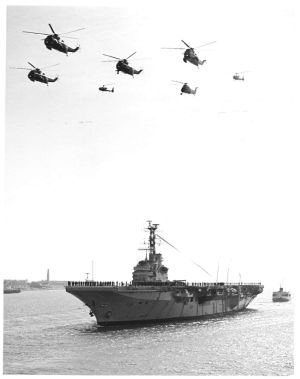HMS Bulwark (R08)
|
|

| |
| Career | 
|
|---|---|
| Ordered: | |
| Laid down: | 10 May 1945 |
| Launched: | 22 June 1948 |
| Commissioned: | 4 November 1954 |
| Decommissioned: | 1981 |
| Fate: | Scrapped |
| Struck: | |
| General Characteristics | |
| Displacement: | 26,200 tonnes (full load |
| Length: | 650 feet/198 metres |
| Beam: | 90 feet/27.4 metres |
| Draught: | 24.5 feet/7.5 metres |
| Propulsion: | 4 Boilers, 2 shafts |
| Speed: | 28 knots (52 km/h) |
| Range: | |
| Complement: | |
| Armament: | |
| Aircraft: | |
| Motto: | "Under thy wings I will trust" |
The sixth HMS Bulwark (R08) of the Royal Navy was a 22,000 tonne Centaur-class light fleet aircraft carrier, launched in 1948.
She was not commissioned until 1954, but once underway, demonstrated the ship's and its crew's dedication to duty. In 1956 she took part in her first operation, during the Suez Crisis, she launched up to 600 sorties in what was then known as Operation Musketeer. In 1958 she assisted two tankers who had collided in the Persian Gulf. She towed one of the tankers, Melika, to Muscat, winning an award for this, namely the Boyd Trophy.
In 1958 she paid off at Portsmouth for conversion into a commando carrier. Her sister-ship Albion would not do so till 1961. In 1960, Bulwark was recommissioned with 42 Commando, Royal Marine and 848 Squadron attached to the carrier. In 1961, due to an increasing threat of invasion of Kuwait by Iraq, Bulwark landed 42 Commando in Kuwait. In the same year, she became the first Royal Navy warship since World War II to commission outside the UK, commissioning instead in Singapore. She also took part in the campaign against Indonesia, during the Indonesian Confrontation. In 1967 she again commissioned in Singapore Naval Dockyard,(HMS Terror), and following her work up, proceeded to Aden to cover the withdrawal and relieve Eagle, spending three months at sea off the coast of Aden and embarking a detachment of the Argyll and Southerland Highlanders. These were disembarked in Plymouth following a visit to Cape Town. A period of dry docking took place in Portsmouth followed by service in the Arctic with 45 commando embarked for exercise Polar Express. Exercises were carried out around the Mediterranean with various allied Navies, with visits to southern France, Italy and Cyprus. Following these exercises she returned to Plymouth RND for de-commissioning in 1969.
In 1972, Bulwark, like her sister-ship Albion, was involved in withdrawals across the declining empire. In 1972 she was HQ ship for Operation Exit, the withdrawal from Malta, an emotional withdrawal for the Royal Navy.
In 1976 she was withdrawn from service and placed in Reserve. In 1979 she was recommissioned as an anti-submarine warfare carrier, due to delays with Invincible, earning her the nickname 'The Rusty B', originating from her motto "Under Thy Wings I Will (T)rust". In 1980 just a year into her new commission, a major fire badly damaged the forward hangar and numerous mess decks.. In March 1981 she returned to Portsmouth for the last time. In April of that year she was put on the disposal list and sent for scrapping the same month.
20 March 1978 refitted at Portsmouth
23 February 1979 recommissioned in Portsmouth
28 June 1979took part in exercise Whiskey Venture with 820 squadron flying Sea Kings and 45 Royal Marine Commando
22nd February took part in exercise Safe Pass of US East Coast
15 march 1980Philadelphia USA. A1 Boiler room destroyed by fire and was not repaired
2 April 1980 returned to Portsmouth
15 April 1980 embarked 45 commando for Exercise Dawn patrol in the Mediterranean off Sardinia
August 1980 took part in exercise Teamwork 80 off Norway
9 November 1980 major fire damaged forward hanger and many mess Decks
27 March 1981 entered Portsmouth for last time time
April 1981 made ready for disposal
10th April taken in tow from Portsmouth to breakers yard
17th April arrived at Cairn Ryan for scrapping
See HMS Bulwark for other ships of this name.
| Centaur-class aircraft carrier |
| Centaur | Albion | Bulwark | Hermes |
| List of aircraft carriers of the Royal Navy |
